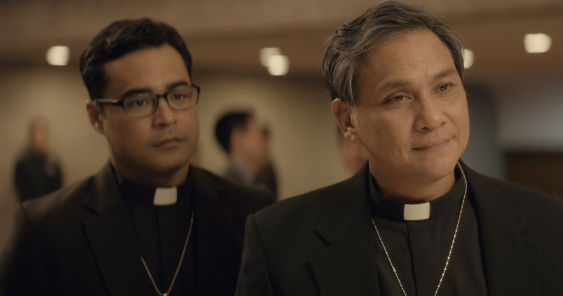For the longest time now, we have been fascinated with serial killers. From “the original” that was Jack the Ripper to Ted Bundy to Jeffrey Dahmer, we have heard about them, feared them, and yet we always want to know about them. There is probably no greater manifestation of this fascination than in Dr. Hannibal Lecter and Buffalo Bill in Thomas Harris’ novel and the fantastic Jonathan Demme-helmed film adaptation of The Silence of the Lambs. Yet for all of the appeal that these individuals have generated in spite of their inherent psychological disorders, the Philippines has never really had any infamous serial killers to catch our collective imaginations. This is where Smaller and Smaller Circles comes in.
F.H. Batacan’s award-winning novel finally hits the big screen, directed by Raya Martin under the auspices of TBA Studios. Batacan casts a pair of Jesuit priests as consultants as a series of murders are committed against young boys in Payatas. Fr. Gus Saenz, S.J. (Nonie Buencamino) and Fr. Jerome Lucero, S.J. (Sid Lucero) are tabbed by NBI Director Francisco Lastimosa (Bembol Roco) for assistance due to their expertise in forensics. Even as they begin to find patterns in the crimes committed against prepubescent boys in Payatas, the Jesuit duo find that it isn’t an open and shut case.
They have to deal with a gloryhound in the NBI in Atty. Ben Arcinas (Raffy Tejada), his own backer who yearns for Lastimosa’s job in Assistant Director Philip Mapa (Christopher de Leon), a powerful bishop who warns the duo not to rock the proverbial boat in Cardinal Meneses (Ricky Davao), and a self-promoting politician seeking reelection in Councilor Mariano (Gladys Reyes). Luckily, they also get help from Joanna Bonifacio (Carla Humphries), a former student of Saenz’s whose journalistic zeal and eye for detail could prove invaluable to the investigation.
First published by UP Press in 2002, Batacan’s novel won the Philippine National Book Award, the Carlos Palanca Memorial Award, and the Madrigal-Gonzalez Best First Book Award. For his part, it’s been more than a decade since he first got wind of the book and joined producer Ria Limjap in securing the rights to adapt it for a motion picture. Limjap then joined forces with Moira Lang in co-writing the adaptation for the big screen.
The performances of Buencamino, Lucero, and Humphries shine the brightest in this film. Jesuits are often interdisciplinary in nature, hence their backgrounds in forensic anthropology and psychology. Filming in their natural milieu, whether it be in a crime lab, a classroom, at the Cultural Center of the Philippines, a soup kitchen, or even on the Ateneo de Manila campus only serves to ground the characters even more. Humphries’ Bonifacio is worldly and definitely not just eye candy as she is comfortable speaking in French with Saenz as easily as she is chugging down a few beers with her crew.

It’s refreshing to witness the whole experience of establishing patterns, making inquiries, and creating a profile of the killer that we have seen in many Western films and event recent television shows like Mindhunter manifested here in more familiar locales. Though their roles are relatively small, Davao, de Leon, Reyes, and especially Tejada resonate as each of them seeks to advance their individual agendas.
The subplot involving Davao’s Cardinal Meneses seems particularly relevant now in light of developments here and abroad, and calls to mind some of the events covered in the 2015 film Spotlight, which is even more fascinating since the Batacan novel was written over a decade earlier. The climactic scene feels influenced by Demme’s aforementioned The Silence of the Lambs, but rather than using nightvision technology, Martin makes use of shadows and natural light in a building where electricity isn’t present everywhere. He also doesn’t glamorize the violence committed against the victims by the killer, although it was a pleasant surprise to see the reasons behind the killer’s behavior during the movie’s denouement.
It was a confluence of events that led to Martin and Limjap reading Batacan’s novel, getting in touch with her and her publishers, tapping up and comers TBA Studios to produce, and finally bring this story to Philippine cinemas. It is a risk, and definitely not one of the formulaic films we’ve come to expect from Filipinos in years past. It is a risk worth taking, however, to not just show that Filipino writers and filmmakers can give their respective takes on this genre, but also to show that the breadth and scope of novels and films from Filipinos can go beyond the very limited borders of past releases.
Click here for an exclusive adobo interview with Director Raya Martin of Smaller and Smaller Circles.







